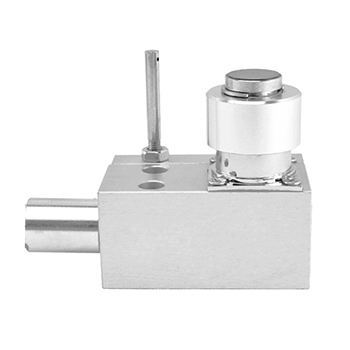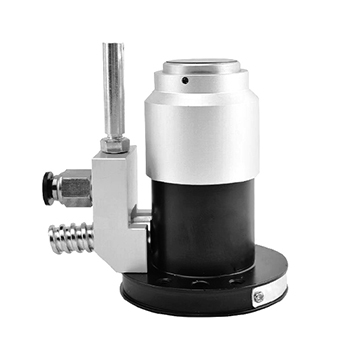What is Tool Setter Used for?
As a relatively important auxiliary instrument for CNC machine tools, the tool setting instrument is used to measure and adjust measuring instruments used in various machining centers, CNC machine tool tools, and axial dimensions during external presetting. So what are the general applications of tool-setting instruments? Let's find out together.
Structure
The core components of the tool setting instrument are mainly composed of a high-precision switch, a high-hardness, a high-wear-resistant carbide tetrahedron (tool setting probe), and a signal transmission interface. The tetrahedron probe is used to make contact with the tool and transmit the force to the high-precision switch through the flexible support rod installed under it.
The on-off signal sent by the switch is transmitted to the CNC system through the signal transmission interface for tool direction recognition, calculation, compensation, access, etc.
The working principle of CNC tool setter machine tools determines that when the machine tool returns to the mechanical reference point of its respective motion axis, the machine tool coordinate system is established. Once the reference point is established, relative to the zero point of the machine tool, each movement direction on each axis of the machine tool coordinate system has a numerical practical meaning.
Application
Measure and compensate tool offset in five directions of ±X, ±Z and Y axes
The tool setting instrument can measure and compensate the tool offset value in five directions, which can effectively eliminate the errors and inefficiencies caused by manual tool setting. No matter what kind of cutting tool (external circle, end face, thread, grooving or milling and drilling dynamic tool on turning center) is used for turning or milling the workpiece contour, all the tool tip points or tool axis lines participating in the cutting. It must be adjusted or compensated to make it exactly on the same theoretical point or axis of the workpiece coordinate system.
For powered rotary tools, in addition to measuring and compensating the offset value in the direction of the tool length, it is also necessary to measure and compensate the offset value in the direction of the tool diameter (the offset value of the two radii separated by the axis line of the tool), otherwise the machine tool cannot process a workpiece with the correct size.
On a machine tool without a tool setter instrument, the offset value of each tool can only be obtained by measuring, calculating and compensating the workpiece size (manual tool setting) after careful trial cutting of each tool, which is time-consuming and laborious. A little carelessness will scrap the workpiece. When the cutter is replaced, this work will be done again. Therefore, tool setting is one of the tasks that take up the longest auxiliary time of machine tools.
The machine tool using the tool setting instrument can automatically set the offset value of the tool to the workpiece coordinate system after tool setting, thereby automatically establishing the workpiece coordinate system. In this case, there is no need to use "G50 command" to establish the workpiece coordinate system in the processing program.
Automatic monitoring, alarm and compensation of tool wear or damage during machining
It is very troublesome to complete the compensation of the wear value on a machine tool without a tool setting instrument. It is necessary to stop the machine tool many times to manually measure the size of the workpiece, and manually modify the obtained wear value. After installing the tool setting instrument, this problem is much simpler, especially after installing the HPPA or HPMA type. For the former, you only need to stop the machine tool after drying a certain number of workpieces according to the wear pattern of the tool, and use the tool setting instrument to perform the tool setting process again; for the latter, you only need to set the number of processing cycles in the program to execute One automatic tool setting can complete the tool compensation work.
For the alarm of tool damage or the replacement of the tool after it is worn to a certain extent, a "threshold value" is set according to the allowable wear amount of the tool. Once the error detected by the tool setting instrument exceeds the threshold value, the tool is considered damaged or exceeds the threshold value. If the allowable wear value is exceeded, the machine tool will automatically alarm and stop, and then force the tool to be replaced.
Compensation of Tool Offset Variation Caused by Thermal Deformation of Machine Tool
All kinds of heat generated by the machine tool during the working cycle will cause the deformation of the machine tool, especially the thermal elongation of the lead screw, which will change the position of the tooltip. As a result, the dimensional accuracy of the processed workpiece will be affected. However, if a tool setting instrument is installed on the machine tool, the above problems can be easily solved. It is nothing more than to regard the position change of the tooltip caused by thermal deformation as the wear value of the tool and measure the tool offset value through the tool setting instrument to solve it.
Precautions for use
- When the tool and the instrument are in contact, the stroke cannot be exceeded, otherwise, the tool will easily damage the instrument. The general stroke is 5mm.
- Do not let go immediately when touching the surface with your hands, so as not to damage the internal structure and affect the service efficiency and life.
- After the tool setting process is finished, lift the tool vertically away from the contact surface, and do not move it laterally to avoid damage.
- There are two main wiring methods. Please connect in different ways when wiring the tool setting instrument.

